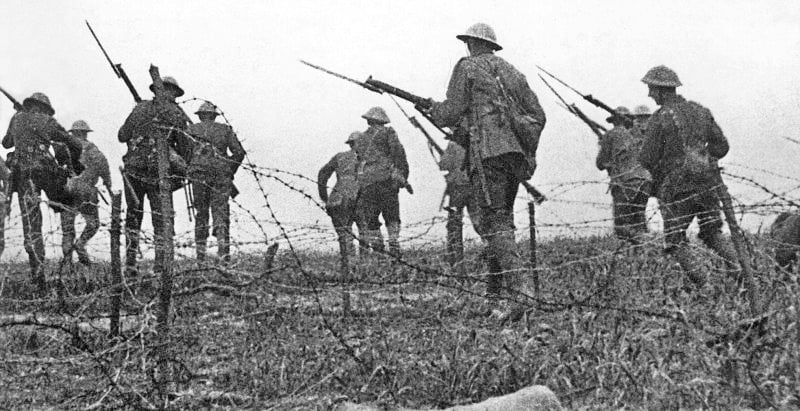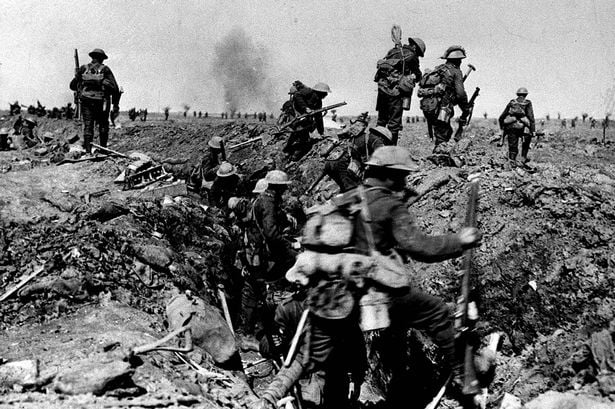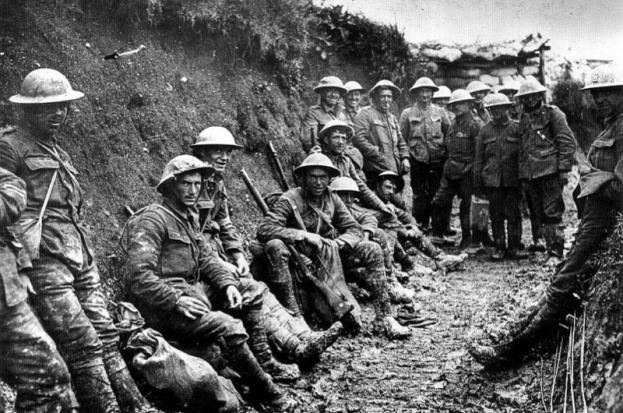July 1, 1916, The Battle of the Somme: General Haig’s Murderous “Great Push Forward”
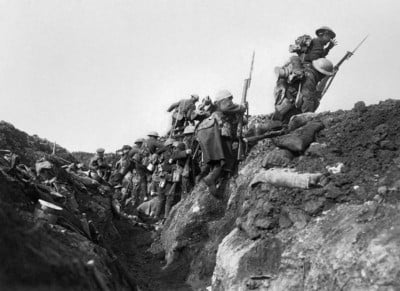
Exactly 100 years ago today, General Douglas Haig, commander-in-chief of the British Army fighting on the continent during World War I, launched a major offensive in a part of northern France that is known as the Département de la Somme. A département is an administrative district, and this one is named after the Somme, the river that meanders lazily through the area from the east to the coast of the English Channel in the west; during World War I, it thus crossed the line of the Western Front, which ran from the Swiss border in the southeast to the North Sea coast in Belgium to the northwest.
The Somme département corresponds more or less to the ancient province of Picardy, whose capital city is Amiens. Most of the ensuing fighting of what would become known as the “Battle of the Somme” was witnessed by the area to the east of Amiens, between the small town of Albert, which was held by the allies, and the towns of Bapaume and Péronne, which were behind the German lines.
The objective of Haig’s offensive was twofold. An immediate aim was to reduce the hellish pressure exerted on the French who were desperately trying to halt a major German offensive aimed at seizing the historic city of Verdun. But Haig also perceived an opportunity to succeed where British and French offensives had failed in 1915, and to win the war by breaking through the strongly defended German lines. He spoke optimistically of the offensive he planned as the “Great Push Forward” or, short and sweet, the “Big Push.” The British military supremo was convinced that God had chosen him personally to guide his country and its allies to victory; of his offensive, he would later say that he “felt that every step in [his] plan had been taken with the Divine help.”
The Somme region had been a particularly calm sector of the Western Front. The British troops stationed there were newcomers to the war, inexperienced recruits who had arrived in France only shortly before. They were not professional soldiers like the members of the British Expeditionary Force (BEF), who had already been thrown into battle at the very start of the war, in the summer of 1914; they were volunteers who had joined the forces in 1914 and 1915, and were collectively known as “Kitchener’s Army,” for they had heeded Lord Kitchener’s famous summons to fight for king and country. The great majority of these men were from Britain itself, that is, from England, Scotland, and Wales, as well as Ireland.
On July 1, 1916, the weather was described as “divine,” but that glorious summer day would turn out to be the darkest date in the history of the British army. At exactly 7:30 in the morning, the British guns that had been shelling the German positions suddenly fell silent and the “Tommies,” as British soldiers were known, “went over the top” or “jumped the bags,” as exiting the trenches was called. In the case of the Surrey Regiment, an officer kicked a soccer ball into the direction of the German trenches when the attack began, as if this were the start of a game or sports contest. In the minds of the still mostly unexperienced Tommies, this stunt created the impression that the situation was under control, that all would be well. Moreover, the officers had assured the men that they would hardly face any opposition: for five consecutive days, an unprecedented array of cannonry, totalling approximately 1,600 guns, had continuously shelled the Germans, firing about one and a half million projectiles; not much was therefore supposed to be left of the German positions and their defenders.
And so the men moved forward through the no man’s land as they had been told, the British way: disciplined and dignified, marching slowly, body upright, shoulder to shoulder. However, the British commanders had not foreseen that all too many German defenders, ensconced in solid tunnels and bunkers up to ten meters deep under the ground, would be able to survive the preliminary artillery bombardment. As soon as the guns ceased to fire, the surviving Germans realized that the attack was imminent, so they rushed out of their shelters with their machine guns. They could not believe their eyes when they saw thousands and thousands of British soldiers approaching through no man`s land, slowly, erect, in neat lines. Countless Tommies were thus mowed down in very little time on that fateful morning. The preliminary shelling, no matter how awesome, had been far less effective than expected because the British shells were of inferior quality, and no less than one quarter of all projectiles fired turned out to be “duds” that did not explode. The waves of British attackers were mowed down, one after the other, by the “meat grinders” (Fleischhackmaschinen) or “sewing machines” (Nähmaschinen), as the Germans called their machine guns.
Still, the Tommies kept surging forward. This was the case, even relatively late in the day, for the Newfoundland Regiment, one of the rare British units involved in the battle that were not from Britain itself. (At the time, the great island in the northwest Atlantic was not yet part of Canada, as it is today, but was still a separate British colony.) In the vicinity of the village of Beaumont-Hamel, 684 of the 752 Newfoundlanders involved fell victim to the machine guns of Germans of whom they never even saw one single specimen. But which British general worried about the loss of a few hundred fishermen, miners, and others workers from a distant and insignificant part of the glorious Empire?
On that fateful “first day on the Somme,” the British Army lost more men than ever before in one single day: approximately 60,000 casualties, maybe more, on a total of 110,000 men who participated in the attack. The German losses allegedly amounted to 8,000 men. The thousands of cavalrymen kept in readiness by Haig waited in vain for the signal to move forward, as the hoped-for breach in the German lines never materialized. The Battle of the Somme started catastrophically on July 1, 1916, but it would drag on until November of that same year, revealing itself to be a Moloch that devoured many more victims. The British ended up registering minimal territorial gains, but arguably more important was the fact that Haig’s scheme had provided some much-needed relief for the beleaguered French around Verdun. In any event, as at Verdun, the losses were enormous. The British suffered casualties totalling approximately a half million men, including at last 125,000 killed, while the French registered 200,000 casualties. The German losses allegedly amounted to about a half million men. To all the forces involved in it, the holocaust at the Somme cost more than one million killed, wounded, missing in action, and prisoners of war.
How could tens of thousands of infantrymen so callously be sent to their death on that fateful first day of July? Ever since the 1960s, it has been fashionable to blame General Haig and his colleagues for their incompetence, if not outright stupidity; the British soldiers were presumably skilful and brave enough, but they happened to be a pride of “lions led by donkeys.” However, demonizing Haig and his colleagues, in other words, blaming the massacre on a handful of individuals, does not provide a satisfactory explanation. Indeed, the Great War witnessed too many other similar cases of generals – not only in the British but also in the French, German, and Russian armies – nonchalantly ordering attacks that amounted to a death sentence for tens if not hundreds of thousands of their own men, for example in the Battles of Tannenberg (1914) and the Chemin des Dames (1917). Many of these commanders were skilled professionals, it would be a mistake to dismiss them all as “donkeys.” However, in the armies of all belligerent countries, the officers in general were overwhelmingly “gentlemen,” members of the social elite, and the generals tended to be aristocrats or members of the highest ranks of the upper-middle class (or bourgeoisie) who had internalized the ethos of the aristocracy – as in the case of Haig. It is this class background of the army hierarchs that can help us to make sense of massacres of minions such as the one that occurred on July 1, 1916.
First of all, it ought to be kept in mind that the nobility had been a “warrior class” since the Middle Ages, and continued to perceive war as a “chivalrous” affair, in which gentlemen of high social rank, the modern incarnations of the “knights in shining armour,” were supposed to play a decisive role. Hence a preference for cavalry and bladed weapons like the sword. Haig a cavalryman himself, had internalized this ethos. He was certainly not an ignoramus, and had learned lessons from the experiences of 1914 and 1915, which had demonstrated the effectiveness of modern (and definitely unchivalrous) weapons of the industrial age, above all artillery; this is why he had ordered the aforementioned preliminary shelling of the German positions. Still, he considered this bombardment as a mere prelude to the real thing, namely, a battle in the style of the supposedly “good old days,” perhaps not the Middle Ages, but those of the Napoleonic Wars: masses of foot soldiers, supported by artillery, would hurl themselves against the enemy line and blow a hole in it; the cavalry, the favourite weapon of the nobility, would then make the decisive move, storming through the gap to roll up enemy lines and harvest the glory of victory.
Haig’s approach reflected the traditional military mindset of the aristocracy, not only with his overestimation of the importance of cavalry, but also with his correspondingly low opinion of the enemy’s foot soldiers and their weapons, even modern rifles. Haig had allegedly persuaded himself that “the ability of bullets to stop horses was greatly exaggerated”; maybe that is only a legend, but it does illustrate his unquestioned confidence in the huge potential of warriors on horseback. Even the machine gun was underestimated: how could a weapon, mass-produced by workers in some anonymous factory and manipulated by any proletarian, prevail over an aristocrat riding high on the “noble” animal that was his horse?
As for the ordinary soldiers of the infantry, was it not inevitable, and customary, for them to suffer huge casualties? Had it not always been like that? And that did not present a problem, because there were so many of them – at home, and in overseas colonies stretching from Newfoundland to India. The elite, not only in Britain but also in Germany, Russia, and elsewhere, appeared to believe that plebeian “raw material” needed to be used in copious amounts in order to enable the warlords to produce victory, and that this human material was in any event virtually inexhaustible. Russian soldiers who had survived the disastrous Battle of Tannenberg complained that their commanders had “acted as if they had at their disposal such millions of men ‘that it does not matter how many are thrown to their deaths.’”
In the big scheme of things, as perceived by the military leadership, the loss even of tens of thousands of proletarians in uniform did not amount to a big deal. Two days after the attack, when Haig received a report stating that the losses amounted to 40,000 men – while in reality they were much higher! – he remarked coolly that “this cannot be considered severe, in view of the numbers engaged, and the length of front attacked.” The death of thousands of soldiers did not cause him any headaches. “We lament too much over death,” he stoically commented on one occasion, “we should regard it as a change to another room.” And he added:
The nation must be taught to bear losses…[and] to see heavy casualty lists for what may appear to the uninitiated to be insufficient object[s]…Three years of war and the loss of one-tenth of the manhood of the nation is not too great a price to pay in so great a cause.
From the perspective of the upper classes within and without the military, the loss of tens of thousands of plebeians was not only perceived to be inevitable, affordable, and rather unimportant, but even beneficial. Like many if not most other members of Britain’s – and Europe’s – elite, a “symbiosis” of the aristocracy and the upper-middle class, generals like Haig perceived the huge numbers of the “lower orders” not only as the cause of proletarian poverty but also as a menace to their own power, wealth, and privileges; from the perspective of the upper classes, the lower classes were what the French called “les classes dangereuses,” “la vile multitude.” The popular “masses” loomed as stupid, aggressive, and dangerous, and simply too numerous, so that the elite welcomed any way in which the number of plebeians in general could be lowered, be made less massive. The solution seemed to be provided by emigration to distant colonies, and, even more so, by Malthusian “positive checks” on the proliferation of the proletariat; these “positive checks” – “positive” in the sense that they increased mortality – included famine and diseases such as tuberculosis, affecting mostly the lower orders, but also war.
War inevitably involved considerable losses on the part of the plebeian foot soldiers, and this was perceived as a kind of pruning or culling, a quantitative cut that improved the quality. (A few years before the outbreak of war in 1914, Lord Frederick Roberts, a British general who had covered himself in glory, as the saying goes, during the wars in India and South Africa, praised war as a way to get rid of “the great human rottenness that is rife in our industrial cities.”) Viewed in this light, the dark cloud of the losses suffered on July 1, 1916, could be deemed by the military, political and social elite to have a silver lining: the casualties were mostly members of Britain’s polloi, the all too numerous, redundant and dangerous “mass” of poor folks, whose ranks had to be thinned out for the benefit of their “betters.” During World War I, some ordinary soldiers were in fact convinced that massacres such as those of July 1, 1916, reflected a desire on the part of their generals to reduce the ranks of the workers and thus to make the fearsome masses less “massive” and less frightful. During one of the many strikes Paris was to witness in June 1919, a striker, reflecting on the Great War, declared that
This war was wanted by the bourgeoisie, the industrial capitalists, and the leaders of all the countries [involved in the war]. They observed the swelling of the ranks of the proletarian organisations and they feared for their coffers. And so they found a solution: eliminating workers by means of war.
Finally, if the plebeian rank-and-file suffered heavy losses, the generals also managed to wash their hands in innocence by arguing that it was the fault of the plebeians themselves. Whose fault, for example, was it that the preliminary shelling had not eliminated sufficient numbers of German defenders because so many shells turned out to be duds? Perhaps the “war-profiteering” manufacturers who earned fortunes by producing ammunition, and who sought to increase their gains by using material of lower quality? As far as Haig was concerned, however, there could be no doubt: the culprits were the British factory workers whom he believed to “have too many holidays and too much to drink.” (“A notable argument,” remarks historian Adam Hochschild, “for someone whose family fortune was based on whiskey.”) Haig suggested in a letter to his wife that it would be a good idea to “take and shoot two or three of them” so that “the ‘Drink habit’ would cease.”
The British generals were of course disappointed that the attack had not produced the desired result. But they were most satisfied with the way in which the men had followed orders and conducted themselves in such a dignified manner. “Where today we might see mindless killing,” writes Adam Hochschild, “many of those who presided over the war’s battles saw only nobility and heroism.” And with respect to the bloodbath of July 1, 1916, he quotes the report of a general:
Not a man shirked going through the extremely heavy barrage, or facing the machine-gun and rifle fire that finally wiped them out…He saw the lines which advanced in such admirable order melting away under the fire. Yet not a man wavered, broke the ranks, or attempted to come back. He has never seen, indeed could never have imagined, such a magnificent display of gallantry, discipline and determination. The report that he had had from the very few survivors of this marvellous advance bear out what he saw with his own eyes, viz, that hardly a man of ours got to the German front line.
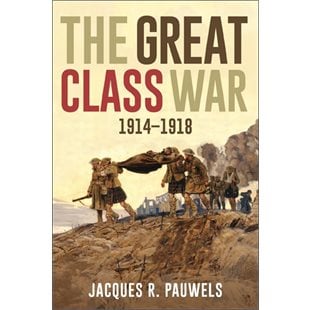 In other words, the military authorities were pleased that the attack, though murderous, had demonstrated that they had managed to inculcate some discipline and class into proletarians who, during the socially turbulent years leading up to the war, punctuated by frequent demonstrations and strikes, had shown themselves to be restless, unruly, recalcitrant, even rebellious. During the attack they had obeyed orders, nicely lined up, like schoolchildren, then advanced slowly and unswervingly through the no man’s land, erect and dignified, just the way their superiors liked to see it. In fact, in order to make this a fine and enjoyable show for the superiors watching from a safe distance, the attack had been scheduled to take place in full daylight.
In other words, the military authorities were pleased that the attack, though murderous, had demonstrated that they had managed to inculcate some discipline and class into proletarians who, during the socially turbulent years leading up to the war, punctuated by frequent demonstrations and strikes, had shown themselves to be restless, unruly, recalcitrant, even rebellious. During the attack they had obeyed orders, nicely lined up, like schoolchildren, then advanced slowly and unswervingly through the no man’s land, erect and dignified, just the way their superiors liked to see it. In fact, in order to make this a fine and enjoyable show for the superiors watching from a safe distance, the attack had been scheduled to take place in full daylight.
The satisfaction of the generals with the performance of their subordinates on July 1 was echoed by the media in Britain. A war correspondent over there reported that, “on balance, [it had been] a good day for England and France. It is a day of promise in this war.” The soldiers themselves, however, saw things in a different light. The Somme offensive, Haig’s “Big Push,” was referred to by the men as “the Great Fuck Up,” a term that would eventually also designate the war in general. It was a term with a double edge, reflecting not only the soldiers’ contempt for the generals, but also their perception of being terribly abused by Haig and their other superiors. The soldiers’ hatred and contempt of the generals was also voiced as follows by a famous war poet, Siegfried Sassoon, in the poem The General:
‘Good-morning; good-morning!’ the General said
When we met him last week on the way to the line.
Now the soldiers he smiled at are most of ‘em dead,
And we’re cursing his staff for incompetent swine.
In this context, it is worth citing a comment from the memoirs of the English writer J. B. Priestley, who acquired a “class conscience” as a result of his experiences as a soldier in the Great War, especially because of the way in which the officers treated their subordinates:
The British command specialised in throwing men away for nothing. The tradition of an upper class…killed most of my friends as surely as if those cavalry generals had come out of the chateaux with polo mallets and beaten our brains out. Call this class prejudice, if you like, so long as you remember…that I went into that war without any such prejudice, free of any class feeling.
The Battle of the Somme provided inspiration for a song that would become a huge hit in Britain, Roses of Picardy, written by a lawyer and famous songwriter, Frederick E. Weatherley. The province of Picardy, more or less the territorial equivalent of the Département of the Somme and therefore the theatre of the great battle, is not known for its roses, those flowers functioned as the powerful symbol of the blood that was spilled in that region, much as the poppies did for Flanders’ Fields. Moreover, as Paul Fussell has noted, roses are closely connected to England and are a symbol of loyalty to the British fatherland. In this song, loyalty to the homeland is closely associated with loyalty to the loved one:
Roses are shining in Picardy
In the hush of the silver dew
Roses are flowering in Picardy
But there’s never a rose like you
And the roses will die with the summer time
And our roads may be far apart
But there’s one rose that dies not in Picardy
‘T is the rose that I keep in my heart.
Roses of Picardy is a beautiful song that was very effective in conjuring up the atmosphere in Britain during and after the Battle of the Somme. But the horror and absurdity of the battle in general and the attack of July 1 in particular are conveyed even more strikingly in the poem After the ‘Offensive’ by Theo Van Beek, an artillery officer:
Waves of strong men
That will surge not again,
Scattered and riven
You lie, and you rot;
What have you not given?
And what – have you got?
Jacques R. Pauwels is the author of The Great Class War 1914-1918, James Lorimer, Toronto, 2016


